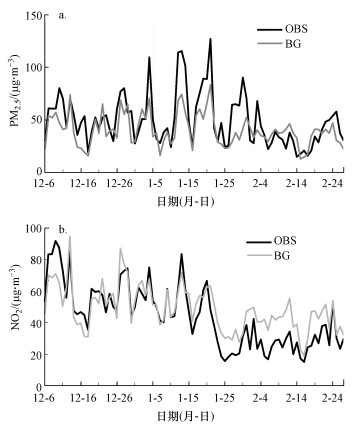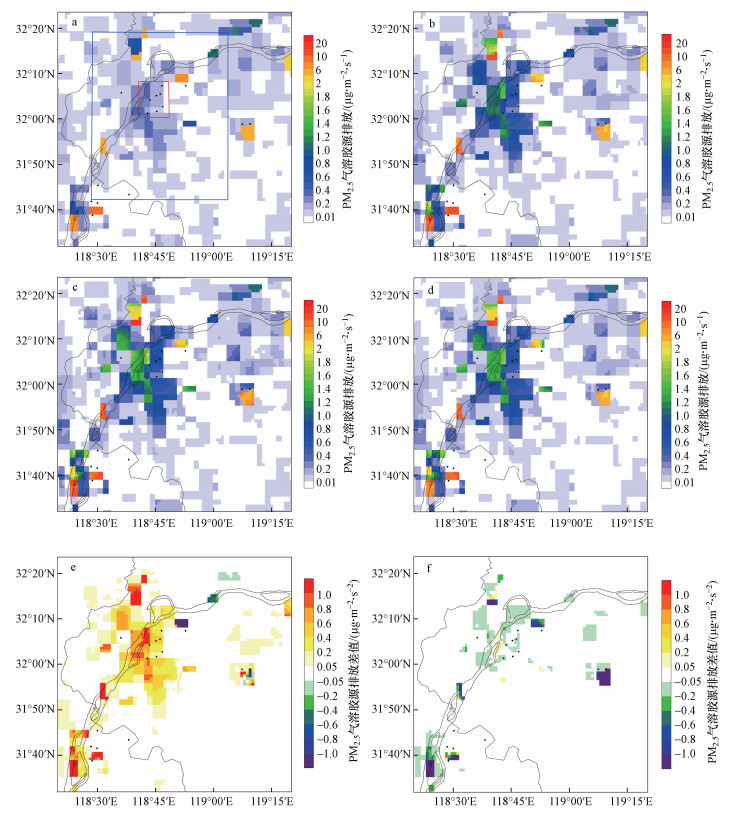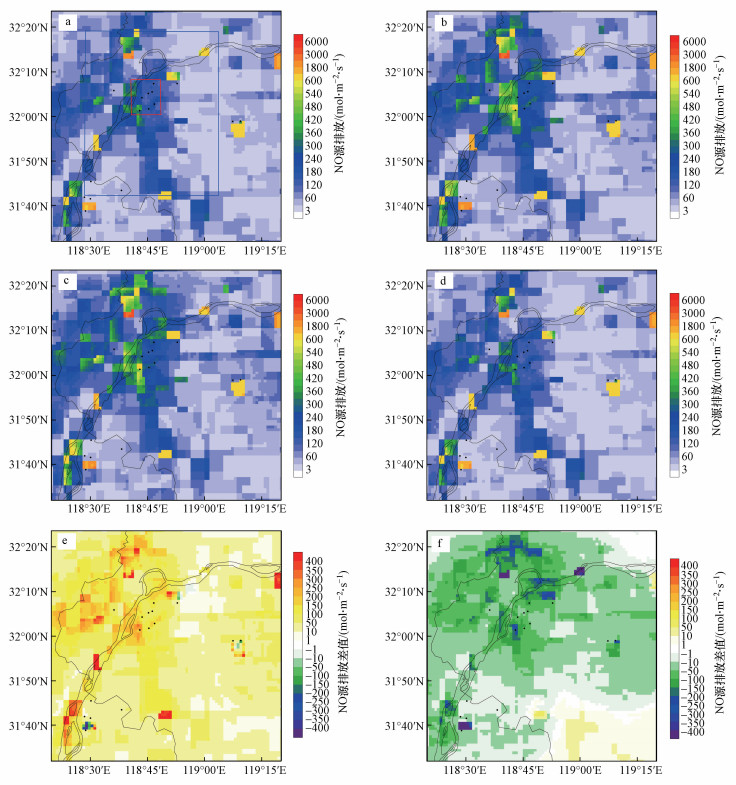2. 南京大学大气科学学院, 南京 210023;
3. 南京浦蓝大气环境研究院有限公司, 南京 211800;
4. 南京创蓝科技有限公司, 南京 211135
2. School of Atmospheric Sciences, Nanjing University, Nanjing 210023;
3. Nanjing Pulan Atmospheric Environment Research Institute Inc., Nangjing 211800;
4. Nanjing CLIMBLUE Technology Co. LTD., Nanjing 211135
2020年初, 新型冠状病毒肺炎(COVID-19)悄然爆发, 为了有效防止疫情扩散和蔓延, 全国主要城市都相继停工停产, 居民居家隔离.在社会生活近乎停摆的形势下, 人类生产生活活动所产生的污染排放(Feng et al., 2020)及大气污染物浓度(Huang et al., 2020; Le et al., 2020; Liu et al., 2021; Shi et al., 2021)也出现了相应的变化.
污染源清单是进行空气污染、环境健康和气候变化等研究的基础数据.当前所广泛使用的污染源清单主要是基于各种基础能源消耗统计数据采用自下而上方法估算出来的.由于能源统计数据、人为活动水平和排放因子的选取存在较大的不确定性, 因此, 利用自下而上的方法得到的污染源清单还存在较大的不确定性(Ma et al., 2004;杨文夷等, 2013;Li et al., 2017a; 2017b;Zheng et al., 2018;Zheng et al., 2021).同时, 在污染源清单编制过程中, 只有少量的污染源排放具有精确的地理坐标, 而包括工业排放在内的大部分源排放是根据各省的统计数据推算得到的, 因此, 现有的污染源排放清单的空间分布仍然存在较大的不确定性(Zheng et al., 2021).此外, 随着经济的高速发展和空气污染控制新技术的应用, 城市能源结构发生了明显的变化, 污染源排放的时空变化非常迅速, 而统计数据的发布一般滞后几年(程兴宏等, 2016;Zheng et al., 2018).因此, 现有的排放清单已经不能反映当前的污染排放现状, 尤其是不能反映2020年初由于新冠疫情全国近乎停摆背景下的污染排放情况.
而基于污染物浓度观测资料, 利用自上而下的反演方法所优化的污染排放源能够有效弥补采用自下而上方法估算污染源排放的不足.理论上, 只要拥有实时的观测, 就能利用同化技术更新得到实时的污染源排放(McLinden et al., 2016).研究表明, 在类似中国这样工农业快速发展的同时严格实施减排措施的国家, 利用反演法得到的污染源能够更好地反映这些国家的污染排放情况(Elguindi et al., 2020).
近年来随着资料同化研究的发展, 已经有较多基于四维变分(Guerrette et al., 2015; Zhang et al., 2015; 2016)和集合卡尔曼滤波(朱江等, 2006; Huneeus et al., 2012; 2013; Schutgens et al., 2012; Miyazaki et al., 2014; Wang et al, 2016)等同化技术建立同化系统优化污染源的工作.目前这些研究大多都是基于较粗的时空分辨率进行的, 本文在以前工作的基础上(Peng et al., 2017; 2018; 2020; Chu et al., 2018), 基于集合卡尔曼滤波同化技术和中尺度传输模式WRF-Chem, 针对新冠肺炎爆发前后南京地区大气污染排放变化, 在1 km的空间尺度上设计逐时的同化实验, 探讨同化技术在高时空分辨率上对污染源排放的优化能力.
2 方法(Methods) 2.1 WRF-Chem模式本文使用的大气化学模式是WRF-Chem 3.6.1(Grell et al., 2005).WRF-Chem是由美国国家大气和海洋局共同研发的气象-化学在线耦合模式, 能够在线模拟气象场和化学场.与Peng等(2018)的研究一致, 本文选择了GOCART气溶胶方案、RACM气相化学机制、YSU边界层参数化方案、RRTM长波辐射和Goddard短波辐射方案、Noah陆面参数化方案等.
本文的模拟区域覆盖了南京及其周边地区(图 1), 模式经向和纬向的网格数目都是96, 水平分辨率为1 km.从地面到10 hPa高空垂直分为57层, 为了更好地模拟边界层以内的污染物垂直分布, 低层分层较密, 高层较为稀疏, 其中, 边界层以内的分层达到了12层.模式的气象初始场和边界条件, 以及化学初始场和边界条件都来自于大尺度的模拟结果.先验的人为污染源来自清华大学的MEIC-2010源清单, 生物排放(Guenther et al., 1995)、海盐(Chin et al., 2000; 2002)和沙尘气溶胶(Ginoux et al., 2001)通过在线模拟得到.
 |
| 图 1 模拟区域及所用到的16个同化观测站 Fig. 1 Model domain and locations of the 16 assimilation observation stations with model topography |
本文所使用的同化模型为集合平方根卡尔曼滤波(Ensemble Square Root Filter, EnSRF)(Whitaker et al., 2002; Schwartz et al., 2012; 2014).相较于EnKF同化方案(Evensen, 1994), EnSRF同化不用额外给观测增加扰动, 从而减少了样本误差.模式的集合样本设为50;同化系统采用了协方差调节法, 以弥补模式误差并保证集合样本有足够的离散度, 其中, 膨胀系数设为1.2;同时, 系统利用Gaspari and Cohn函数滤去虚假的远距离相关, 实验中局地化半径为15 km.
实验所用观测资料为南京及周边城市共16个观测站的PM2.5、PM10、SO2、NO2、CO和O3逐时浓度观测数据, 其中, 南京地区有9个站.为了更有效地利用观测资料信息, 参考Peng等(2018)的研究, 本文也采用了同时对污染物浓度和污染源进行同化的协同同化方案, 其中, 同化的污染物浓度包括16种气溶胶成分和4种污染气体: SO2、NO2、CO和O3, 污染源包括EPM2.5、EPM10、ESO2、ENO、ENH3和ECO(其中, E表示污染源排放).为了避免交叉相关, PM2.5观测资料同化细颗粒气溶胶浓度和EPM2.5;PM10~2.5观测(PM10~2.5表征粗颗粒气溶胶)同化粗颗粒气溶胶浓度和EPM10;SO2观测同化SO2浓度和ESO2;NO2观测同化NO2浓度和ENO;CO观测同化CO浓度和ECO;O3观测同化O3浓度;由于缺乏NH3观测, ENH3由PM2.5观测资料进行优化.因此, 本课题组得到的数值产品有逐时的污染物浓度分析场和逐时的污染源排放.
2.3 实验设计从2020年1月23日起, 中国主要城市陆续实行了居民居家隔离、企业停工停产等措施.1月24日起, 江苏省启动突发公共卫生事情一级响应(http://www.nanjing.gov.cn/zt/yqfk/zccs/202001/t20200127_1782811.html), 南京市政府要求除了涉及疫情防控必需的企业生产, 钢铁、化工等连续生产企业, 以及与民生相关的行业可以正常经营以外, 其他行业复工复产的时间不早于2月8日24:00.2月10日起, 南京市开始有序推动企业复工复产(http://www.nanjing.gov.cn/zt/yqfk/ldhd/202002/t20200210_1788707.html), 2月25日24:00起, 随着疫情逐渐得到有效控制, 江苏省将疫情防控应急响应级别调整为二级响应(http://www.nanjing.gov.cn/zt/yqfk/zccs/202002/t20200225_1797629.html).之后, 居民生活逐步步入正轨, 企业生产逐渐恢复.根据南京地区疫情管控情况, 本文同化实验模拟时间设为2019年12月1日—2020年2月28日.
3 结果与分析(Results and analysis)如上所述, 同化实验的时间设置为2019年12月1日—2020年2月28日, 由于2019年12月1—5日为模式初始化时期, 舍去不予分析, 因此, 本研究分析的时间为2019年12月6日—2020年2月28日.虽然本研究得到的是逐时的污染物浓度分析场和污染源排放, 但为了更好地反映污染源排放随时间的变化, 分析时去除了污染源日变化的影响, 在日平均和月平均的基础上进行分析.根据南京市疫情管控情况, 将分析时间分为以下3个时段: 2019年12月6—31日(代表2019年12月)、2020年1月1—24日(代表2020年1月)和2020年1月25日—2月28日(代表2020年2月, 表征疫情管控后的源排放).由于疫情管控影响最大的是以交通和工业排放为主的NO排放, 此外, 对气溶胶排放也有一定的影响, 而对其他源排放的影响较小, 因此, 本文着重分析疫情管控对南京地区气溶胶排放EPM2.5和NO排放ENO的影响.
图 2为南京城区PM2.5气溶胶和NO2浓度的集合模拟与观测的对比, 由图可见, 集合模拟结果与观测资料非常一致, 其中, PM2.5气溶胶观测的平均值为48.0 μg·m-3, 模式误差为-8.3 μg·m-3;NO2的平均值为44.2 μg·m-3, 模式误差为-4.8 μg·m-3.这些统计表明同化实验有效吸收了观测信息, 因此, 集合模拟结果与观测非常接近, 误差较小.
 |
| 图 2 南京城区PM2.5气溶胶(a)和NO2 (b) 浓度的日平均变化趋势 (OBS为城区6个观测站(奥体中心、草场门、瑞金路、山西路、玄武湖和中华门)观测资料的平均, BG为城区6个观测站集合模拟的平均) Fig. 2 Time series of the daily mean concentrations of PM2.5(a) and NO2(b) in the downtown area of Nanjing |
从图 2还可以看到, 受新冠疫情管控影响, 南京市区PM2.5气溶胶和NO2浓度明显减小.疫情管控前, 南京市区的PM2.5气溶胶浓度观测1月平均为60.2 μg·m-3, 疫情管控以后的2月的观测值减小到38.9 μg·m-3, 减小了35.4%.管控前平均的NO2观测值为50.7 μg·m-3, 管控以后NO2观测值减小到27.0 μg·m-3, 减小了46.8%.
图 3a和图 4分别为实验期间南京及其周边地区的PM2.5气溶胶源排放的时空分布.由图可见, 先验的PM2.5气溶胶主要排放区域在南京市郊的浦口工业区和金陵石化所在的新港开发区, 以及以钢铁深加工为特色的马鞍山地区, 而其他地区的排放整体较小, 其中, 南京城区的日平均排放为0.23 μg·m-2·s-1, 整个南京地区的排放为0.13 μg·m-2·s-1. 同化以后, 以2019年12月的同化结果为例, 除新港开发区的排放明显减小以外, 整个模拟区域的排放都大幅增加, 尤其是浦口工业区、南京城区和马鞍山地区增加得最为明显, 其中, 南京城区PM2.5气溶胶源排放平均值达到0.70 μg·m-2·s-1, 整个南京地区的排放也达到0.25 μg·m-2·s-1.这些结果表明先验源是偏小的, 这与上文模拟结果比观测整体偏小的结论一致.
 |
| 图 3 优化后的PM2.5气溶胶(a)和NO (b) 源排放 (黑色实线AN Downtown为南京城区(图 4a中红色方框所示的范围)同化后的污染源排放,灰色实线PR Downtown为南京城区同化前的污染源排放, 黑色虚线AN Nanjing为整个南京地区(图 4a中蓝色方框所示的范围)的同化后的污染源排放,灰色虚线PR Nanjing为整个南京地区同化前的污染源排放,这里AN表示同化以后的污染源,PR表示同化以前的先验源) Fig. 3 Time series of the daily mean emissions extracted from the analyzed emissions and the prescribed emissions in the whole city and the city center of Nanjing of PM2.5(a) and NO(b) respectively |
 |
| 图 4 南京市PM2.5气溶胶源排放的空间分布 (a.先验源, b.2019年12月优化源的平均, c.2020年1月优化源的平均, d.2020年2月优化源的平均, e.2019年12月优化源与先验源的差值, f.2020年2月优化源与1月优化源的差值;图中蓝色方框代表整个南京地区, 红色方框代表南京城区) Fig. 4 Spatial distribution of PM2.5 emissions of the prescribed(a), the monthly mean analysis in December 2019 (b), January 2020 (c) and February 2020(d), the differences between the analysis emissions in December 2019 and the prescribed values(e), and the differences between the analysis emissions in February 2020 and those in January 2020 (f) (The blue square marks the area of the whole Nanjing city and the red one markes its downtown) |
2020年1月25日疫情管控以后, 南京市气溶胶排放先短暂上升(1月25—31日), 这与春节期间少量的烟花燃放有关;同时这几天气温偏低(最低气温都在0 ℃左右), 因此相比较其他时段, 居民需要燃烧更多的燃料取暖、烧水烧饭等, 从而导致PM2.5气溶胶排放增加;之后, PM2.5气溶胶排放整体偏低, 这与疫情管控、企业停工停产有关;同时因为居民外出活动减少, 交通排放也在一定程度上减少了气溶胶的排放.整体上模拟区域2月排放比1月小4.4%(图 4).
南京地区的NO源排放主要来自交通和工业.图 3b和图 5为实验期间南京及周边地区NO源排放的时空分布.由图 5可见, 除主要的工业区外, 南京城区也有一定的排放, 但先验NO源排放明显偏小, 同化前南京地区的先验源排放平均为176.5 mol·km-2·h-1, 城区平均为99.3 mol·km-2·h-1.优化后在主要工业区和南京城区都有明显增加: 12月南京城区达到了316.0 mol·km-2·h-1, 整个南京地区的NO排放达到了185.2 mol·km-2·h-1, 较先验源分别增加了79.0%和86.5%.
 |
| 图 5 南京市NO源排放的空间分布 (a.先验源, b.2019年12月优化源的平均, c.2020年1月优化源的平均, d.2020年2月优化源的平均, e.2019年12月优化源和先验源的差值, f.2020年2月优化源和1月优化源的差值) Fig. 5 Spatial distribution of NO emissions of (a) the prescribed, the monthly mean analysis in December 2019 (b), January 2020 (c) and February 2020 (d), the differences between the analysis emissions in December 2019 and the prescribed values (e), and the differences between the analysis emissions in February 2020 and those in January 2020 (f) (The blue square marks the area of the whole Nanjing city and the red one markes its downtown) (The blue square marks the area of the whole Nanjing city and the red one markes its downtown) |
由图 3b可以看到, 2019年12月11日—2020年1月13日期间, 南京地区的NO排放在190 mol·km-2·h-1左右, 城区排放在300 mol·km-2·h-1左右.之后的1月14—24日, 南京地区NO排放逐渐减小, 这与学生寒假开始、交通出行减少有关;同时临近春节过年, 部分企业停工停产, 因此, NO排放也相应减小.1月25—2月24日期间, 南京地区NO整体排放都非常小.这是因为疫情爆发, 江苏省实行公共卫生一级响应, 要求居民居家隔离、企业停工停产, 使得NO排放大幅度减小.在2月25日以后, 疫情逐步稳定, 江苏省调整为二级响应, 企业逐步有序地开始复工, NO排放逐渐增加.结合图 5可以看到, 整体上, 2月的NO排放比1月大幅度减小了30%, 其中, 1月南京地区的平均排放为196.6 mol·km-2·h-1, 城区为290.6 mol·km-2·h-1, 而2月南京地区的排放减小到133.2 mol·km-2·h-1, 城区排放减小到204.1 mol·km-2·h-1.
4 结论(Conclusions)本文针对新冠肺炎爆发前后南京地区大气污染排放变化, 在1 km空间尺度上进行了逐时同化实验模拟研究.结果表明, 同化系统能够很好地再现疫情管控前后南京地区的污染源时空分布.疫情爆发前, 优化源明显大于先验源, 尤其是在工业区和城区增幅明显, 表明先验源较实际偏小, 这与背景浓度小于观测值的结论一致;随着疫情管控, 南京市区的PM2.5气溶胶和NO源排放分别较管控前减少4.4%和30%, 减少的区域主要位于工业区和城区.这些结果表明同化系统在反演高时空分辨率的污染源方面具有很好的潜力.
但本文的结果仍存在一定的局限性, 相对于模式的网格数目, 观测站的数量非常有限, 而且主要分布在南京城区, 工业区观测相对较少, 因此, 同化结果仍可能存在一定的误差.未来可以考虑增加更多的地面观测, 或者尝试引入卫星雷达等多源数据进行优化.
Chin M, Rood R B, Lin S J, et al. 2000. Atmospheric sulfur cycle simulated in the global model GOCART: Model description and global properties[J]. Journal of Geophysical Research: Atmospheres, 105(D20): 24671-24687. DOI:10.1029/2000JD900384 |
Chin M, Ginoux P, Kinne S, et al. 2002. Tropospheric aerosol optical thickness from the GOCART model and comparisons with satellite and Sun photometer measurements[J]. Journal of the Atmospheric Sciences, 59: 461-483. DOI:10.1175/1520-0469(2002)059<0461:TAOTFT>2.0.CO;2 |
Chu K, Peng Z, Liu L, et al. 2018. Evaluating the impact of emissions regulations on the emissions reduction during the 2015 China Victory Day Parade with an ensemble square root filter[J]. Journal of Geophysical Research: Atmospheres. DOI:10.1002/2017JD027631 |
程兴宏. 2008. 空气质量模式"源同化"模型及排放源影响效应研究[J]. 北京: 中国科学院研究生院: 1-149. |
Elguindi N, Granier C, Stavrakou T, et al. 2020. Intercomparison of magnitudes and trends in anthropogenic surface emissions from bottom-up inventories, top-down estimates, and emission scenarios[J]. Earth's Future, 8. DOI:10.1029/2020EF001520 |
Evensen G. 1994. Sequential data assimilation with a nonlinear quasi-geostrophic model using Monte Carlo methods to forecast error statistcs[J]. Journal of Geophysical Research, 99: 10143-10162. DOI:10.1029/94JC00572 |
Feng S, Jiang F, Wang H, et al. 2020. NOx emission changes over China during the COVID-19 epidemic inferred from surface NO2 observations[J]. Geophysical Research Letters, 47: e2020GL090080. |
Ginoux P, Chin M, Tegen I, et al. 2001. Sources and distributions of dust aerosols simulated with the GOCART model[J]. Journal of Geophysical Research, 106: 20255-20273. DOI:10.1029/2000JD000053 |
Grell G, Peckham S E, Schmitz R, et al. 2005. Fully coupled "online" chemistry within the WRF model[J]. Atmospheric Environment, 39: 6957-6975. DOI:10.1016/j.atmosenv.2005.04.027 |
Guenther A, Hewitt C N, Erickson D, et al. 1995. A global model of natural volatile organic compound emissions[J]. Journal Geophysical Research, 100: 8873-8892. DOI:10.1029/94JD02950 |
Guerrette J J, Henze D K. 2015. Development and application of the WRFPLUS-Chem online chemistry adjoint and WRFDA-Chem assimilation system[J]. Geoscientific Model Development Discussions, 8: 1857-1876. DOI:10.5194/gmd-8-1857-2015 |
Henze D K, Hakami A, Seinfeld J H. 2007. Development of the adjoint of GEOS-Chem[J]. Atmospheric Chemistry Physics, 8: 2413-2433. |
Huang X, Ding A, Gao J, et al. 2020. Enhanced secondary pollution offset reduction of primary emissions ruing COVID-19 lockdown in China[J]. National Science Review. DOI:10.1093/nsr/nwaa137 |
Huneeus N, Chevallier F, Boucher O. 2012. Estimating aerosol emissions by assimilating observed aerosol optical depth in a global aerosol model[J]. Atmospheric Chemistry Physics, 12: 4585-4606. DOI:10.5194/acp-12-4585-2012 |
Huneeus N, Boucher O, Chevallier F. 2013. Atmospheric inversion of SO2 and primary aerosol emissions for the year 2010[J]. Atmospheric Chemistry Physics, 13: 6555-6573. DOI:10.5194/acp-13-6555-2013 |
Le T, Wang Y, Liu L, et al. 2020. Unexpected air pollution with marked emission reductions during the COVID-19 outbreak in China[J]. Science, 369(6504): 702-706. DOI:10.1126/science.abb7431 |
Li M, Zhang Q, Kurokawa J I, et al. 2017a. MIX: a mosaic Asian anthropogenic emission inventory under the international collaboration framework of the MICS-Asia and HTAP[J]. Atmospheric Chemistry Physics, 17: 935-963. DOI:10.5194/acp-17-935-2017 |
Li M, Liu H, Geng G, et al. 2017b. Anthropogenic emission inventories in China: A review[J]. National Science Review, 4: 834-866. |
Liu L, Zhang J, Du R, Teng X, et al. 2021. Chemistry of atmospheric fine particles during the COVID-19 pandemic in a megacity of Eastern China[J]. Geophysical Research Letters, 48: e2020GL091611. |
Ma J, van Aardenne J A. 2004. Impact of different emission inventories on simulated tropospheric ozone over China: a regional chemical transport model evaluation[J]. Atmospheric Chemistry Physics, 4: 877-887. DOI:10.5194/acp-4-877-2004 |
McLinden C A, Fioletov V, Shephard M W, et al. 2016. Space-based detection of missing sulfur dioxide sources of global air pollution[J]. Nature Geoscience, 9: 496-500. DOI:10.1038/ngeo2724 |
Miyazaki K, Eskes H J, Sudo K, et al. 2014. Global lightning NOx production estimated by an assimilation of multiple satellite data sets[J]. Atmospheric Chemistry Physics, 14: 3277-3305. DOI:10.5194/acp-14-3277-2014 |
Peng Z, Lei L L, Liu Z Q, et al. 2020. Impact of assimilating meteorological observations on source emissions estimate and 1 chemical simulations[J]. Geophysical Research Letters. DOI:10.1029/2020GL089030 |
Peng Z, Lei L, Liu Z, et al. 2018. The impact of multi-species surface chemical observation assimilation on air quality forecasts in China[J]. Atmospheric Chemistry and Physics, 18(23): 17387-17404. DOI:10.5194/acp-18-17387-2018 |
Peng Z, Liu Z, Chen D, et al. 2017. Improving PM2.5 forecast over China by the joint adjustment of initial conditions and source emissions with an ensemble Kalman filter[J]. Atmospheric Chemistry and Physics, 17(7): 4837-4855. DOI:10.5194/acp-17-4837-2017 |
Schutgens N, Nakata M, Nakajima T., et al. 2012. Estimating aerosol emissions by assimilating remote sensing observations into a global transport model[J]. Remote Sensing, 4(11): 3528-3543. DOI:10.3390/rs4113528 |
Schwartz C S, Liu Z, Lin H C. 2012. Simultaneous three-dimensional variational assimilation of surface fine particulate matter and MODIS aerosol optical depth[J]. Journal of Geophysical Research Atmospheres: 117. |
Schwartz C S, Liu Z, Lin H C, et al. 2014. Assimilating aerosol observations with a "hybrid" variational-ensemble data assimilation system[J]. Journal of Geophysical Research Atmospheres, 119: 4043-4069. |
Shi Z B, Song C B, Liu B W, et al. 2021. Abrupt but smaller than expected changes in surface air quality attributable to COVID-19 lockdowns[J]. Science Advances, 7: eabd6696. DOI:10.1126/sciadv.abd6696 |
Wang P, Wang H, Wang Y Q, et al. 2016. Inverse modeling of black carbon emissions over China using ensemble data assimilation[J]. Atmospheric Chemistry Physics, 16: 989-1002. DOI:10.5194/acp-16-989-2016 |
Whitaker J S, Hamill T M. 2002. Ensemble data assimilation without perturbed observations[J]. Monthly Weather Review, 130: 1913-1924. |
杨文夷, 李杰, 朱莉莉, 等. 2013. 我国空气污染物人为源排放清单对比[J]. 环境科学研究, 26(7): 703-711. |
Zhang L, Liu L, Zhao Y, et al. 2015. Source attribution of particulate matter pollution over North China with the adjoint method[J]. Environmental Research Letters, 10: 084011. |
Zhang L, Shao J Y, Lu X, et al. 2016. Sources and processes affecting fine particulate matter pollution over North China: An adjoint analysis of the Beijing APEC Period[J]. Environment Science Technology, 50(16): 8731-8740. |
Zheng B, Tong D, Li M, et al. 2018. Trends in China's anthropogenic emissions since 2010 as the consequence of clean air actions[J]. Atmospheric Chemistry and Physics, 18: 14095-14111. |
Zheng B, Cheng J, Geng G, et al. 2021. Mapping anthropogenic emissions in China at 1 km spatial resolution and its application in air quality modeling[J]. Science Bulletin, 66: 612-620. |
朱江, 汪萍. 2006. 集合卡尔曼平滑和集合卡尔曼滤波在污染源反演中的应用[J]. 大气科学, 30(5): 871-882. |
 2021, Vol. 41
2021, Vol. 41


